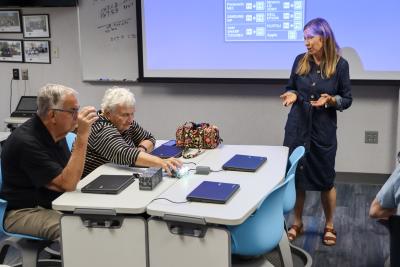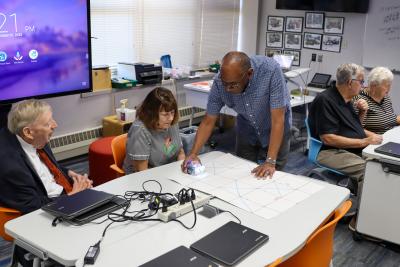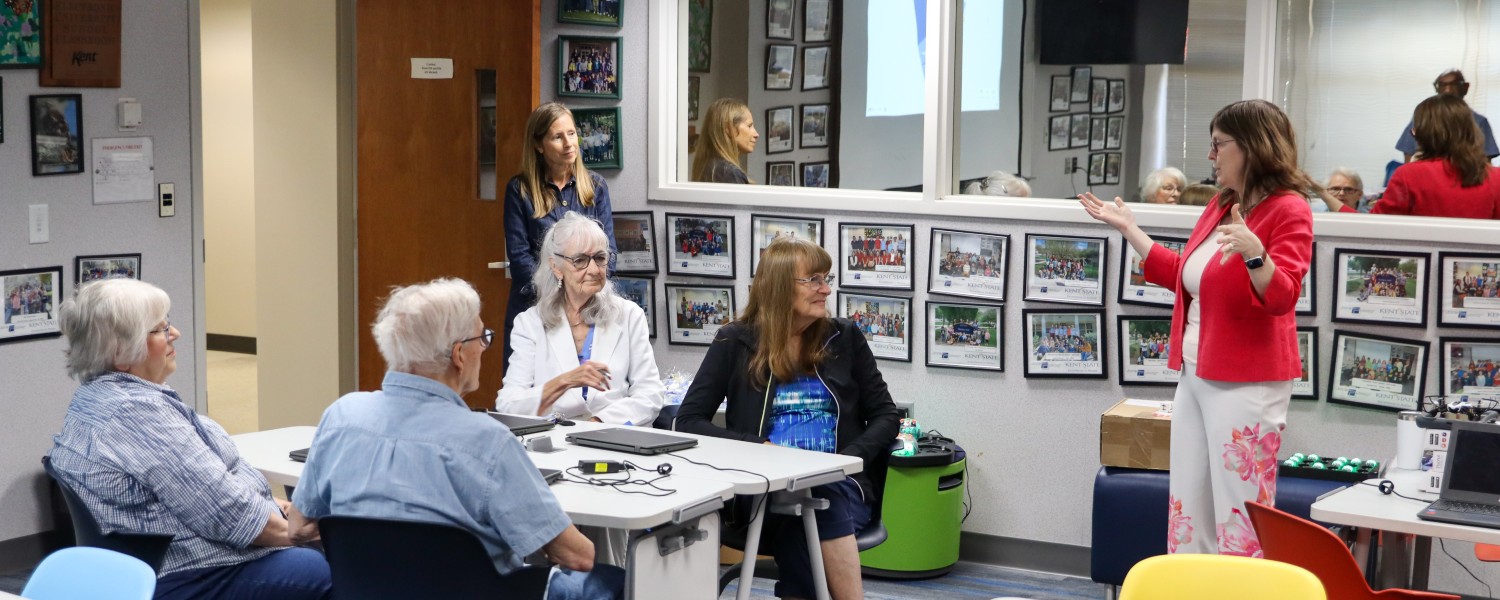A small group of former educators from the Portage County Retired Teachers Association (PCRTA) were tutored on the virtues of Â鶹ąű¶łâ€™s AT&T Classroom.
Some of the retirees taught children in that very same space during what proved to be an integral period of the classroom’s early development. For them, revisiting was an opportunity to see how much the space – and the technology – has advanced. For the others, it was an unfamiliar place that spurred curiosity and aided learning.

“Our goal in hosting the group was to honor the legacy of local educators who played a pivotal role in establishing the AT&T Classroom, while also reconnecting them with our center’s current work,” said Annette Kratcoski, director of The Research Center for Educational Technology (RCET). “By engaging retired teachers, we strengthen community ties, showcase how RCET continues to advance innovative teaching and learning, and inspire ongoing support and advocacy for preparing future teachers.”
Kay Wise and Frank Seman, a former librarian and principal at Brown Middle School in Ravenna, were two of the very first teachers to participate in the AT&T Classroom in the late 90’s. They’re in one of the many pictures that hang on the walls. During their time in the classroom floppy discs and CD-ROMs – technology developed in the 80’s – ruled the day. Back then, high tech was an mp3 or minidisc player. The Internet was a blip on the radar and AOL Instant Messenger was a sorry substitute for social media.
Wise said 25 years ago teachers used overhead projectors to facilitate classroom learning. “That was new to us to project it on the screen,” she said. “I saw that it isn’t there anymore so that’s an old form of technology.”
Thomas McNeal, Technology Project Director at RCET, introduced Wise and her colleagues to tiny robots on wheels. The devices are used to teach children new skills at places like the Child Development Center on the Kent Campus.
For nearly two decades, McNeal has taught students of all ages, but this was his first time instructing seniors. “They took to them really well,” said McNeal. “We started out with lower-level Blue Bots that can be programmed with buttons. Then we moved on to Ozobot Evos that you can program with markers by drawing lines on a piece of paper.” Tiny lights on the front of Ozobots flash a color that corresponds to the color of the line drawn.
“Many of the grant proposals originated from teachers who participated in the AT&T Classroom, and whose projects were designed to build on that experience,” said Kratcoski. “The AT&T

Classroom was built on the willingness of educators like Kay and Frank to try something new. Their early involvement helped shape the program into what it is today, and that same spirit of innovation continues to guide our support for practicing teachers and preparing for the next generation of educators.”
Nestled in the basement of Moulton Hall, the AT&T Classroom is part of RCET, a program launched in 1999 to examine the probability that technology can enhance teaching and learning.
PCRTA awards five $2500 scholarships to high school seniors pursuing majors in education. It also provides mini grants to Portage County teachers interested in developing innovative classroom projects. Not surprisingly, Wise explained that one teacher spent her grant on Blue Bots for the class.
“The AT&T Classroom has been an innovative model for pre-service and in-service teacher learning for over 25 years, changing the content focus with ever-emerging technologies but always focusing on supporting teachers to teach in new and different ways” said Alicia Crowe, interim dean for the College of Education, Health and Human Services. “I am eager to see what’s next for teacher learning in this space.”

